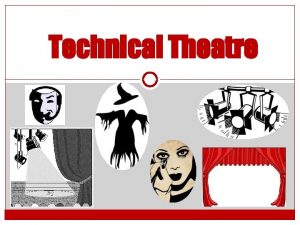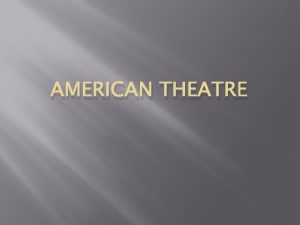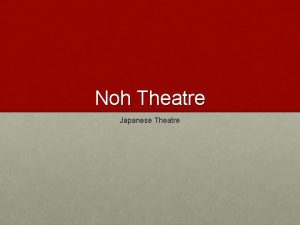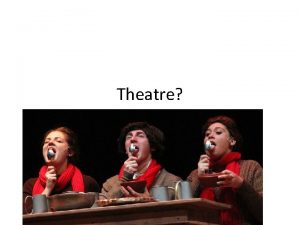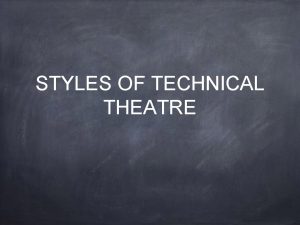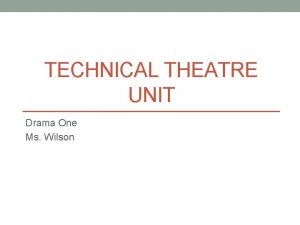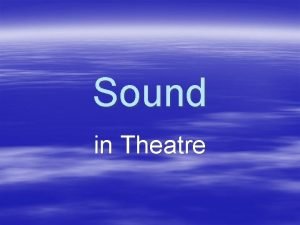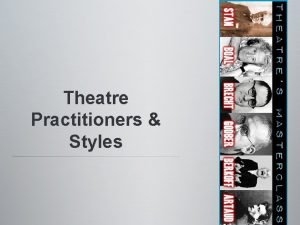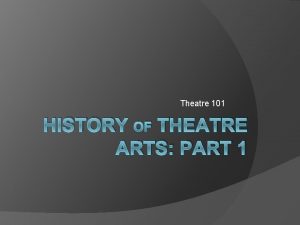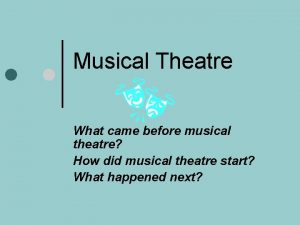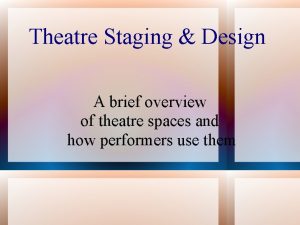TECHNICAL THEATRE UNIT Technical Theatre Unit Using the











































- Slides: 43

TECHNICAL THEATRE UNIT

Technical Theatre Unit • Using the poems/songs that we just performed, we will be creating a “production” piece by piece. • You MUST bring your poem/song with you to class each day! • If you did not present a poem/song, you must turn one in tomorrow, or I will select one for you.

We will be doing… • Set design • Sound design • Blocking • Costume design • Building a set • Makeup design model • Prop design • Lighting design • Budgeting • Publicity • Resume writing

Details • Most of the work will be completed in class, but there will be some homework. • There will be in-class deadlines, and I will periodically check your progress. • Even after I have checked your assignments, you MUST keep them – they will be submitted in a final portfolio at the end of the unit! • Total points = 70 points!!

READY?

Set Design • Designing the background and set pieces for a production • Set designer • There is also a set crew/shifting crew • Set pieces include: • Flats • Furniture (Couch, chairs, table, bed, etc. )

Flats

Set Sketch

Set Sketch • Ask yourself, what do you visualize in your scene? • On a piece of paper, begin to list items that you need • For example: • 1 table • 2 chairs • 2 flats • Red paint • Below your list, make a rough sketch of your set

Set Model • Now that you have finished your set sketch, you will turn it into a set model! • Ideas to make your set model • Cereal box • Cracker box • Shoe box

Set Model • Due Tuesday October 1 st! • Does not need to be colored, but it can be • Make sure that you include the elements you used in your set sketch!

Blocking • Blocking – coordinating an actor’s movement onstage • Page 183 -184, Page 285 • Blocking can also include facial expressions, hand gestures, and emotions

Blocking • You will be blocking your character’s movements on your copy of your poem/song • Can use symbols, abbreviations, or whole words • Be sure to include physical movements (sitting, standing), facial expressions (frown, smile), and emotion descriptions (happy, sad)

Lighting • Lighting can be used to set the mood for a scene or to highlight certain things • Colored gels can be used for certain moods/settings • “Natural” light is accomplished through the use of light yellow or amber gels

Lighting • White light, or light without a gel, can be used to set a mood as well but can often wash an actor out • Spotlights can be used to highlight someone or something • Background lighting is projected onto the cyc; other lights point directly onto the stage

Lighting • You will be designing lighting for your show • Questions to ask: • Do I want colored lights? What color? Why? • Do I want “natural” light? Why? • Do I want white light? Why? • Do I need a spotlight?

Sound • Shows need sound to help establish setting and to interact with characters • Sound effects are small bits of sound played at specific times • Examples: • Doorbell/knock • Birds chirping • Wind

Sound • Sound effects can be pre-recorded or live • Sound also includes music – both in a show and during scene changes • For your portfolio, you will: • List what sound effects you need • Are they pre-recorded or live? • List a song that you would use to match your production – include title and artist!

• Blocking • On your poem, describe your character’s movement using words or symbols • Include physical movements, facial expressions, and emotion descriptions • Lighting • On a separate piece of paper, describe your lighting • Colored, Natural, White, Combo -- Why? Spotlight? • Sound • Under “Lighting, ” list your sound effects • Pre-recorded or live? • List your matching song (title and artist)

Costumes • When first costuming a character, we have to know what we are working with • As a director, you will then create a vision for what the character would wear and look like • You will create a list of the costume items that you need

Costumes • What do you envision your speaker wearing? • Remember, costumes includes clothing AND accessories. • Take a moment to count ALL the items you are wearing…

Costumes • We WOULDN’T just say: • Shirt • Pants • Shoes • Jewelry

Costumes • We WOULD say: • Peach long-sleeved button-down shirt with polka dot trim • Black skinny jeans • Black ballet flats with bows • Chunky gold watch and bracelet • Long black chain necklace

Costumes • Under “Lighting, ” make a heading for “Costumes” • Begin by listing the important characteristics of your speaker • Age: ____ • Gender: ____ • Height: ____ • Weight: ____ • Hair Color: ____ • Eye Color: ____ • Ethnicity: ____

Costumes • Now that you know the physical qualities of your speaker, make a list of the items that your speaker will be wearing. • Remember, be as detailed as possible! • NOT: Shirt, shoes, pants • YES: Peach long-sleeved button-down shirt with polka dot trim, Black skinny jeans, Black ballet flats with bows

Makeup • Makeup is NOT just lipstick and blush • Makeup includes wrinkles, moles, circles under the eyes, wounds, latex, sci-fi, and more • Makeup also includes hair and hairstyling, which is critical to a character’s ensemble • Every speaker WILL need some kind of makeup


Makeup • We WOULDN’T say: • Green makeup

Makeup • We WOULD say: • Green face and body paint with reptile accent • Green latex horns on face • Shaved head • Red/pink eye shadow all around eyes • Red-orange lipstick • White fingernails

Makeup • If you have a traditional look: • Stage makeup packs • Yes, even boys use these! • If you don’t have a traditional look: • Sci-fi, latex, wounds • Aging makeup (wrinkles, moles, latex) • Circles under the eyes, bags under the eyes to look sad/tired

Makeup • First, envision what your speaker needs • Under “Costumes, ” create a heading for “Makeup” • Under “Makeup, ” list all of the makeup that your character would need and how they will wear it. INCLUDES HAIRSTYLE! • NOT: Green makeup • YES: Green face and body paint with reptile accent with green latex horns on face

BRING CRAYONS, COLORED PENCILS, AND/OR MARKERS TOMORROW!

• Costume Sketch • On a new piece of paper, make a full-body sketch of your speaker wearing his/her costume • Color the sketch to match your descriptions • If you don’t have coloring utensils, you must label each item with its appropriate color • Makeup Sketch • Next to your costume sketch, create a second sketch of your speaker’s face, adding the makeup that he/she will be wearing • Color the sketch to match your descriptions • If you don’t have coloring utensils, you must label the sketch with its appropriate color

20 MINUTES: BRAINSTORM ITEMS TO PUT ON YOUR RESUME. BEGIN SORTING AND FORMATTING THEM ON A PIECE OF NOTEBOOK PAPER. This would also be the time to ask if you are unsure if something should go on your resume or to make an appointment with me for tech/editing help!

Props • Any small items that an actor might handle on stage • Set pieces = big, props = small • Props can be made or purchased • Small details!

Example • The Importance of Being Earnest • Serving trays • Tea set (cups, plates, teapot, sugar bowl) • Tablecloths • Cucumber sandwiches • Sherry bottle and glasses • Cigarette case • Small purse with notepad and pencil • Bell • Golf pencil

Props • Below your Costumes and Makeup list, list the prop items that you will need • Think about the small details that make your set believable • You should have the following items completed by now: • Set Sketch • Blocking • Lights list • Sound list • Costumes list - Makeup list - Costume Sketch - Makeup Sketch - Props list

Announcements • AVHS Confessions • Drama Club Shirts • Resumes

Budgeting • Directors work closely with producers to calculate a budge for the production • You always want to earn more money from tickets than your production cost • Ways to save money: make as many of your own items as possible, rent items, swap with other theatres, plan ahead

Budgeting • Budget your: • Set • Lights • Sounds • Props • Costumes • Makeup • Next to every item you have listed, estimate a total price

Example • Set Sketch • Two flats -- $45 x 2 = $90 • 1 table -- $50 • 2 chairs -- $50

Note • For Lights and Sound, assume that your cost is the rental of theatre building • Theatre rental is around $300 per night. It will come equipped with a light and sound system. • Therefore, gels would be your only additional cost

Budgeting • List a cost for every item on the following lists: • Set sketch • Lights (theatre rental and gels) • Sound (theatre rental) • Props • Costumes • Makeup • You may use your phones to look up the cost of items. • If you are not sure, make your best guess!
 Technical theatre vocabulary
Technical theatre vocabulary Hình ảnh bộ gõ cơ thể búng tay
Hình ảnh bộ gõ cơ thể búng tay Slidetodoc
Slidetodoc Bổ thể
Bổ thể Tỉ lệ cơ thể trẻ em
Tỉ lệ cơ thể trẻ em Chó sói
Chó sói Tư thế worms-breton
Tư thế worms-breton Chúa yêu trần thế
Chúa yêu trần thế Các môn thể thao bắt đầu bằng tiếng đua
Các môn thể thao bắt đầu bằng tiếng đua Thế nào là hệ số cao nhất
Thế nào là hệ số cao nhất Các châu lục và đại dương trên thế giới
Các châu lục và đại dương trên thế giới Công thức tính thế năng
Công thức tính thế năng Trời xanh đây là của chúng ta thể thơ
Trời xanh đây là của chúng ta thể thơ Mật thư anh em như thể tay chân
Mật thư anh em như thể tay chân 101012 bằng
101012 bằng độ dài liên kết
độ dài liên kết Các châu lục và đại dương trên thế giới
Các châu lục và đại dương trên thế giới Thể thơ truyền thống
Thể thơ truyền thống Quá trình desamine hóa có thể tạo ra
Quá trình desamine hóa có thể tạo ra Một số thể thơ truyền thống
Một số thể thơ truyền thống Cái miệng nó xinh thế
Cái miệng nó xinh thế Vẽ hình chiếu vuông góc của vật thể sau
Vẽ hình chiếu vuông góc của vật thể sau Thế nào là sự mỏi cơ
Thế nào là sự mỏi cơ đặc điểm cơ thể của người tối cổ
đặc điểm cơ thể của người tối cổ V cc
V cc Vẽ hình chiếu đứng bằng cạnh của vật thể
Vẽ hình chiếu đứng bằng cạnh của vật thể Phối cảnh
Phối cảnh Thẻ vin
Thẻ vin đại từ thay thế
đại từ thay thế điện thế nghỉ
điện thế nghỉ Tư thế ngồi viết
Tư thế ngồi viết Diễn thế sinh thái là
Diễn thế sinh thái là Các loại đột biến cấu trúc nhiễm sắc thể
Các loại đột biến cấu trúc nhiễm sắc thể Các số nguyên tố là gì
Các số nguyên tố là gì Tư thế ngồi viết
Tư thế ngồi viết Lời thề hippocrates
Lời thề hippocrates Thiếu nhi thế giới liên hoan
Thiếu nhi thế giới liên hoan ưu thế lai là gì
ưu thế lai là gì Hươu thường đẻ mỗi lứa mấy con
Hươu thường đẻ mỗi lứa mấy con Khi nào hổ mẹ dạy hổ con săn mồi
Khi nào hổ mẹ dạy hổ con săn mồi Sơ đồ cơ thể người
Sơ đồ cơ thể người Từ ngữ thể hiện lòng nhân hậu
Từ ngữ thể hiện lòng nhân hậu Thế nào là mạng điện lắp đặt kiểu nổi
Thế nào là mạng điện lắp đặt kiểu nổi System.collections.generics
System.collections.generics
